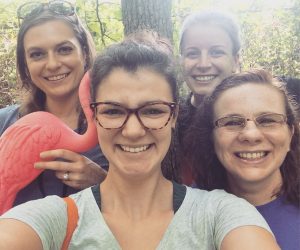When I think about my internship, I think about all of the amazing experiences I got to enjoy, from looking at photos from around the world to small mammal capture and release. The only thing I truly wish is that it would have lasted longer as I didn’t want my time to end.
For me I’m not sure if I could pinpoint just one interesting moment but I can say I really enjoyed looking and identifying animals from different areas of the world. It was so funny because you would always know when someone found something interesting as we (Lena, Nicole, and myself) would be oooing or ahhhing. Stephanie, our mentor, would then chuckle as she had seen what seemed like 10,000 of what we had just saw for the first time. It really gave me an idea of what my students must feel when they experience something for the first time. It reminded me that even though I know exactly what will happen when it comes to labs, chuckle with my students, “ooo” and “ahh” with them too.
Everything was not easy when it came to the process of actually working with the data. There were times when the site would decide that it didn’t want to cooperate that day and therefore we would not be able to get the data necessary for the lesson plan. Although this was frustrating at times it was nice to have it happen so that I now know how to mix things up if it happens with my students.
My time at the Natural Science Museum was incredible. We spent most of our time in the biodiversity lab working directly with eMammal. However we did get to explore the other labs and the collections departments. It was nice to have the VIP treatment and be able to see and explore places that are off limits to the public. I would say the best ‘extra’ part of our group was being able to go to Prairie Ridge and do small mammal trapping.
I really enjoyed working with my mentor Stephanie Shuttler. I learned so much from her and she made the whole process fun and enjoyable. It was amazing the photos that she would be able to show us that were taking from students around the world. She explained that the majority of research is done in nature parks, and this has given scientist an opportunity to see animals outside of a protected area and see how they are interacting with the influence of humans.
Although I was very sad to leave the museum after those three short weeks, I am so excited to bring everything I learned back into my classroom. The biggest thing for me was remembering what it is like to be a student. I can’t wait to share with them the mistakes and errors we made that resulted in us trying something new and ending with a great experience. The need to know that it is ok to fail and make mistakes. You just have to pick yourself back up and continue on the course.

